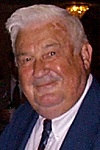Obituaries

Charles F. Heinig, MD
March 9, 1929 - June 20, 2019
Charles Frederick Heinig, MD (Jake) was born in Vernon, NY on March 3, 1929.
He died in Gloucester VA on June 20, 2019 at the age of 90.
A hand written letter to his family shortly before he passed away provides an insight into this bigger than life physician. He began his orthopedic and medical training on the family farm in New York. Engineering and carpentry skills were strengthened as he cut trees, fashioned timbers and mixed concrete to help the family rebuild their barn during WWII. He records his fascination of the natural world on a cross country trip in 1939. The mechanical wonder of the one month old Golden Gate Bridge would remain with him throughout his productive life and career.
Jake referred to the “transfer of knowledge” from all of ones experiences to his profession. Watching tree bark grow over a barbed wire fence helped him visualize the effect of hardware applied to the skeletal structures. He transferred his observations of the mechanical and natural world to the care of his patients.
His formal academic training included Hamilton College. Internship and residency years were with Dr. Robert O. Becker. Additional training was with John J. Fahey, MD, Bill Green, MD, David Grice, MD, and Sherman S. Coleman, MD. Dr. Heinig’s investigation of spinal stenosis started in his residency years studying the works of Dr. Charles Ellsworth describing, “unzipping” the lamina for treatment of a “peculiar disease” in 1898.
Charles F Heinig was a lifelong learner. He was a welder, heavy equipment operator, machinist, and award winning wood carver. But most of all he was a skilled orthopedic surgeon and compassionate physician. He followed the advice of Dr. Fahey: “Remember your patients and what happened to them, then you’ll learn what you can do”. Jake used his training and insight to expand on the work of Kruger and Michelle to perfect the Egg Shell procedure (later referred to as a pedicle subtraction/vertebral body resection). He worked with Dr.Eduardo Luque to expand the usage of segmental instrumentation and sublaminar wiring. His innovations included a pedicle screw that could accept a Harringtion rod or a wire. The Isola instrumentation system was a collaborative effort involving many folks including Dr.Marc Asher, Walt Strippgen, and Dr. William Carson.
He retired from the Miller Clinic in Charlotte, NC in 1989. During his career he worked in the underserved counties of eastern North Carolina. Education and advancement of his profession was a part of his life. The Scoliosis Research Society aided in this aspect of his work as healer. Many orthopedic residents have benefited from his teaching. Even in his retirement Jake was always willing to review a case, collaborate on a new device or weld a broken part on your tractor.
Charles F Heinig, MD left in his writings a list of lessons learned.
These included:
Know what you can do.
Follow your patients for years.
Read others work, believe the believable and question everything.
Teach by showing, talking and displays.
Showing proof is believable.
Remember metal is dumb, it may be beneficial when used thoughtfully.
The history of the spine is as variable as there are spines.
Algorithms are the hobgoblins of man's minds.
Patient care, operative or not, should be tailored to each individual.
Rods and screws for rigid fixation I fear is going to haunt us. Metal is Dumb. As the spine shortens; rods, hooks, and screws will break or migrate.
Always the big man with the big hands he had an even larger place in his heart for those in need. Memorials may be directed to Hamilton College or FOCOS founded by Oheneba Boachie-Adjei, MD.
Jake, your family, colleagues, friends, and most of all your patients celebrate your remarkable 90 years of making us all better people.
Written by Samuel J. Chewning Jr., MD.



